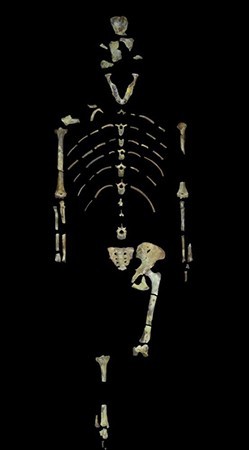By Ana Verayo, | December 01, 2016

The fossils that make up the Lucy skeleton. (JOHN KAPPELMAN/UNIVERSITY OF TEXAS AT AUSTIN)
New bone scans of Lucy has revealed more clues about early human behavior, including her transition from primate-like, climbing movements on trees to walking upright. Lucy is one of the most complete ancient human specimens of an Australopithecus afarensis ever found. It is estimated to be 3.18 million years old.
Like Us on Facebook
In this new study, researchers from the Johns Hopkins University School of Medicine say that Lucy had long arms like a chimp, but was her movements similar to one? Scientists sought to solve the mystery of whether Lucy inherited these movements from another chimp-like ancestor.
According to Christopher Ruff from the Johns Hopkins University School of Medicine, new analysis of Lucy's upper arm bone reveals that early hominins developed arm strength most likely from climbing trees. Researchers obtained high-resolution X-rays which suggest that Lucy may have been regularly climbing trees since upper limb bones this strong do not develop with minimal climbing.
The team also studied Lucy's femur. They suggested that her walking posture was more chimp-like than human. Lucy's limb bones provide crucial evidence about her daily movements. These new findings indicate that she supported her weight when climbing trees.
The most recent study of Lucy suggests she died from falling off a tree. This also indicates that her family may have spent some time dwelling in trees.
However, previous studies speculated that Lucy lived on land more than swinging across trees, as Lucy was also thought to possess flat feet like humans since apes who live in trees have feet that appeared like hands due to grasping branches.
Scientists, however, now state that Lucy and other Australopithecus afarensis ancestors dwelled both on land and tree habitats. Apes that live on trees still have the ability to walk on the ground when they need to, but they do not possess the upright gait of humans or the Australopithecus.
This new study was published in the journal, PLOS ONE.
-
Use of Coronavirus Pandemic Drones Raises Privacy Concerns: Drones Spread Fear, Local Officials Say

-
Coronavirus Hampers The Delivery Of Lockheed Martin F-35 Stealth Fighters For 2020

-
Instagram Speeds Up Plans to Add Account Memorialization Feature Due to COVID-19 Deaths

-
NASA: Perseverance Plans to Bring 'Mars Rock' to Earth in 2031

-
600 Dead And 3,000 In The Hospital as Iranians Believed Drinking High-Concentrations of Alcohol Can Cure The Coronavirus

-
600 Dead And 3,000 In The Hospital as Iranians Believed Drinking High-Concentrations of Alcohol Can Cure The Coronavirus

-
COVID-19: Doctors, Nurses Use Virtual Reality to Learn New Skills in Treating Coronavirus Patients







